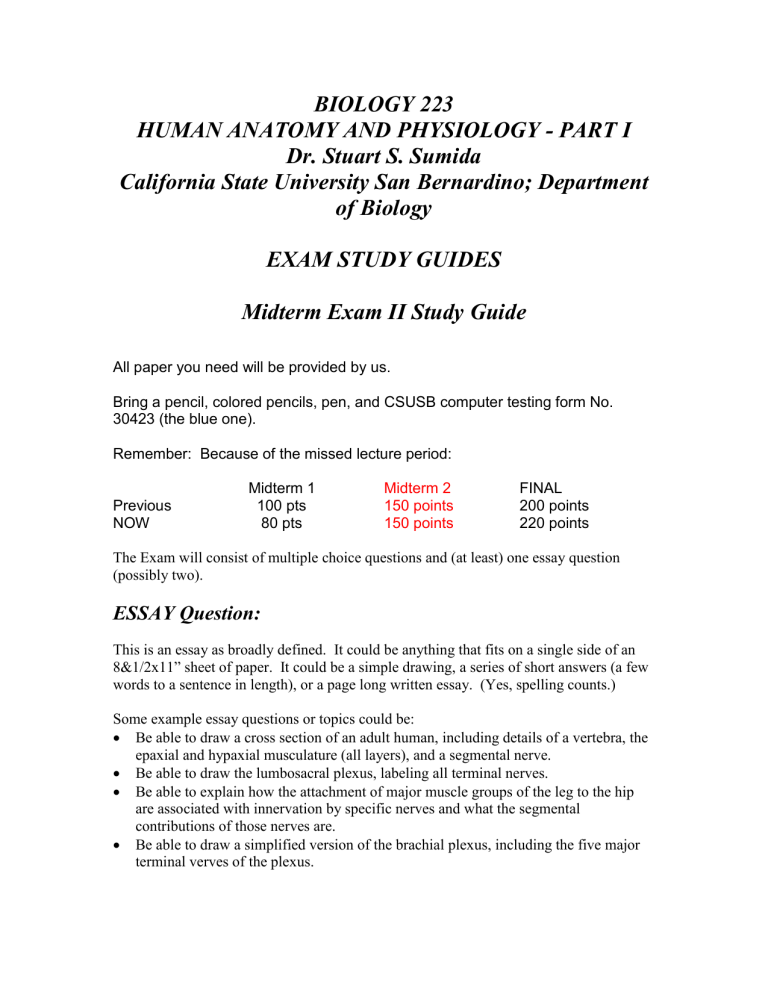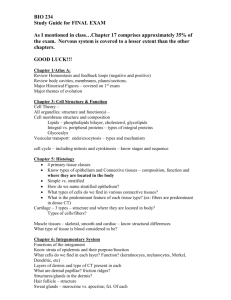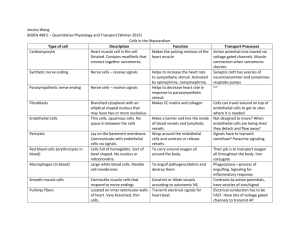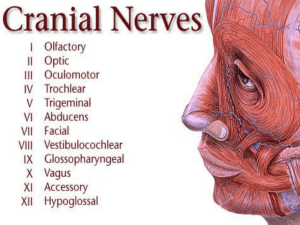Midterm Exam Study Guide

BIOLOGY 223
HUMAN ANATOMY AND PHYSIOLOGY - PART I
Dr. Stuart S. Sumida
California State University San Bernardino; Department of Biology
EXAM STUDY GUIDES
Midterm Exam II Study Guide
All paper you need will be provided by us.
Bring a pencil, colored pencils, pen, and CSUSB computer testing form No.
30423 (the blue one).
Remember: Because of the missed lecture period:
Previous
NOW
Midterm 1
100 pts
80 pts
Midterm 2
150 points
150 points
FINAL
200 points
220 points
The Exam will consist of multiple choice questions and (at least) one essay question
(possibly two).
ESSAY Question:
This is an essay as broadly defined. It could be anything that fits on a single side of an
8&1/2x11” sheet of paper. It could be a simple drawing, a series of short answers (a few words to a sentence in length), or a page long written essay. (Yes, spelling counts.)
Some example essay questions or topics could be:
Be able to draw a cross section of an adult human, including details of a vertebra, the epaxial and hypaxial musculature (all layers), and a segmental nerve.
Be able to draw the lumbosacral plexus, labeling all terminal nerves.
Be able to explain how the attachment of major muscle groups of the leg to the hip are associated with innervation by specific nerves and what the segmental contributions of those nerves are.
Be able to draw a simplified version of the brachial plexus, including the five major terminal verves of the plexus.
Example Multiple Choice Questions:
THIS IS NOT AN EXHAUSTIVE OR COMPREHENSIVE LIST. THEY ARE
SIMPLE EXAMPLE QUESTIONS TO GIVE YOU AN IDEA OF HOW QUESTIONS
ARE ASKED. CORRECT ASNSWERS ARE MARKED IN RED.
1.
Caudal to the level of the umbilicus, the connective tissue sheath surrounding which of the following muscles splits to pass both superficial and deep to the rectus abdominus muscle and aid in forming the rectus sheath?
A.
external oblique
B.
internal oblique
C.
transversus abdominus
D.
transversus thoracis
E.
none of the above.
2.
The interosseus membrane between the tibia and fibula:
A.
aids in weight bearing.
B.
may not be removed without loss of strength or stability.
C.
transfers force between the two bones.
D.
serves as a surface for muscular attachment.
E.
All of the above.
3.
Which of the following is serially homologous to the internal oblique muscle?
A.
internal intercostal
B.
sphincters of the anus and urethra
C.
levator ani
D.
A and B
E.
A and C
4.
Of the following muscles, which is the epaxial muscle placed most laterally?
A.
transversospinalis
B.
longissimus thoracis
C.
longissimus capitis
D.
iliocostalis
E.
transversus abdominus
5.
Consider the proximal and distal attachments of the sartorious muscle. With them in mind, what function(s) will the muscle have?
A.
lateral rotation of the leg
B.
extension of the knee
C.
flexion of the hip
D.
all of the above
E.
none of the above
6.
Which of the following structures will not be associated in some way with the adult derivatives of the embryonic foregut?
A.
Vagus nerve (cranial nerve X)
B.
Celiac artery
C.
Greater splanchnic nerve
D.
Celiac ganglion and plexus
E.
Postganglionic cell bodies synapsing in the sympathetic trunk
7.
Calcium ions:
A.
will bind to troponin to allow muscular contraction.
B.
inhibit the secretion of neurotransmitters at the synapse.
C.
are permanently stored in the skeletal system.
D.
flow in with sodium when the membrane of an axon is depolarized.
E.
are the only type of ion in tropomyosin, the crystalline component of bone.
8.
You are a brilliant physician in a San Bernardino hospital emergency room. A patient comes into the emergency room with the following complaint: "I have no feeling in my calf muscles." You immediately stun him by declaring: "I haven't memorized the names of all those leg muscles, but...
A.
"you must have damage in spinal segments L2,3,4."
B.
"you must have damage in spinal .I know that you must have damage somewhere near spinal segments L5,S1,2."
C.
"you must have damage in spinal .I know that you must have damage somewhere near spinal segments S2,3,4."
D.
"Sorry I can help you I only menorized the muscle names."
9.
Which of the following groups contains a structure that is not serially homologous to the others?
A.
External oblique, external intercostal, sphincter of anus
B.
Internal oblique, internal intercostal, levator ani
C.
Transversus thoracis, transversus abdominus, coccygeus
D.
Atlas, axis, sacrum
10.
Muscles that attach to the anterior superior iliac spine will be innervated by:
A.
the obturator nerve
B.
segments L5,S1,S2
C.
the sciatic nerve
D.
segments L2, L3, L4
E.
the peroneal division of the sciatic nerve only
11.
If a signal is sent through nerve fibers of the ventral division of spinal segments
L2,3,4...
A.
calcium ions would flood into axon terminals in the biceps femoris.
B.
depolarization would occur at the endplate of the sarcoplasmic reticulum of the
vastus lateralis.
C.
an action potential would be carried through the transverse tubules of the
adductor longus.
D.
sodium ions would flood into the sarcoplasmic reticulum of the soleus muscle.
12.
Which of the following muscles do not cross over two joints?
A.
semitendinosus
B.
gracilis
C.
vastus lateralis
D.
rectus femoris
E.
gastrocnemius
13.
The plantar surface (sole) of the foot:
A.
is innervated by cranial dorsal nerve segments.
B.
faces ventrally in the embryo.
C.
is innervated by both caudal dorsal and cranial ventral nerve segments.
D.
can be elevated off the ground by pulling up on the calcaneus by the tibialis posterior muscle.
E.
can be describe by none of the above.







